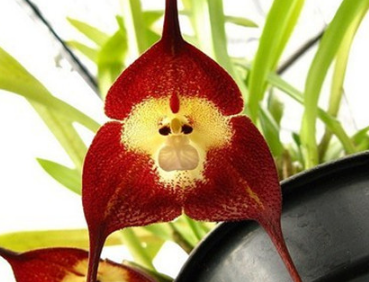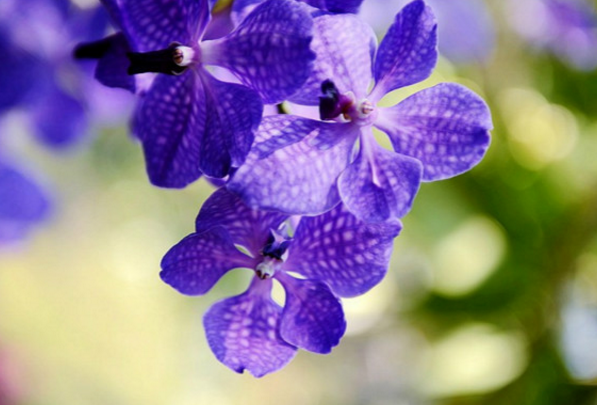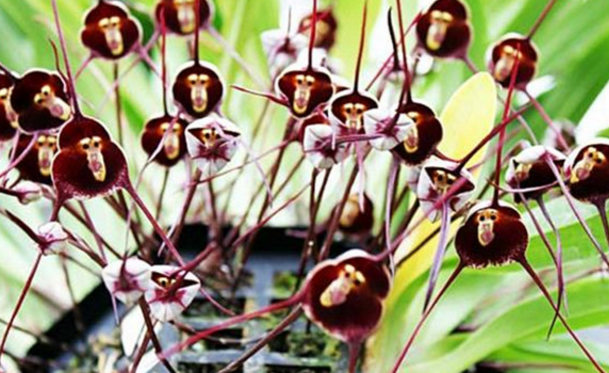The main value of the culture method of monkey face and small dragon orchid
Monkey face Little Dragon Orchid, also known as monkey face orchid, is another masterpiece of nature's miraculous craftsmanship, not only hitting our big brother Sun WuKong, but also a faint smell of flowers, which makes people really want to start a pot and watch it every day!

The culture method of monkey face small dragon orchid
Monkey-faced dragon orchid, named for its petals and calyx resembling monkeys, is mainly distributed in Ecuador and Colombia.
The culture method of monkey-faced small dragon orchid:
1. Soil
Monkey face small dragon orchid prefers acidic matrix, which requires loose ventilation, good drainage, and can keep the root moist without stagnant water. Generally, the substrate can be used for orchid cultivation.
2. Water and fertilizer management
There is not much demand for fertilizer and water, and they are afraid of random fertilization, concentrated fertilizer and partial application of nitrogen, phosphorus and potash fertilizer. It is required to follow the fertilization (water) principle of "frequent application of light fertilizer, less and more times, and complete nutrition".
3. Temperature and humidity
Temperature: monkey face small dragon orchid likes cold climate, afraid of hot, difficult to spend summer; not resistant to frost, when the temperature drops below 10 ℃, it will go into dormancy. The most suitable growth temperature is 15-28 ℃.
Humidity: monkey face small dragon orchid likes the dry air environment, overcast and rainy days are too long, easy to be infected by bacteria. For fear of rain, keep the leaves dry at night. The optimum air relative humidity is 40 ~ 65%.
4. Lighting conditions
Monkey face small dragon orchid in late autumn, winter, early spring three seasons, because the temperature is not very high, it should be given direct sunlight, in order to facilitate its photosynthesis and the formation of flower buds, flowering, fruiting. If you encounter hot weather or in summer, you need to shield it from about 50% of the sun. For indoor maintenance and viewing after flowering, it should be placed near the southeast doors and windows in order to prolong the flowering period and increase the number of flowers as much as possible.
5. Methods of reproduction
Monkey-faced Magnolia can be propagated by sowing, dividing plants and other methods.
Monkey face Xiaolong Orchid domestic keeping points for attention:
1. Maintenance of monkey face small dragon orchid during florescence
The flowers of Monkey face Little Dragon Orchid are the origin of the name, so take good care of the monkey's face during flowering. Flowering, watering should not be too much, to prevent rotting roots, and do not water like leaves and petals to prevent flower pattern from being destroyed.
2. Common diseases and insect pests of monkey-faced small dragon orchid
There are many common diseases in monkey face, such as wilt, anthracnose, white silk disease, leaf blight, tiller rot, root rot and so on.
Monkey-faced small dragon orchid common pests: shell insects, aphids, snails and slugs and so on.
The main value of monkey face Xiaolong orchid
1. The main value of Monkey face Little Dragon Orchid: ornamental
Monkey face small dragon orchid is a small epiphytic orchid, with short stolons, 30-40 cm high, stout stems, hollow. Leaves decussate, broadly ovoid. Take root on the node of the earth. Broadly ovoid, nearly equal in length and width, slightly narrower in upper part. Leaves Obovate-lanceolate.
Sparse racemes, flowers opposite in leaf axils, funnelform, yellow, usually with purplish red patches or spots, pedicels growing from the base, calyx petals and petals into three petals, with labial petals in the center. The seeds are small. It blossoms from April to May. Often cultivated at the age of 1-2 years.
The strange image of the monkey-faced dragon orchid is familiar to most flower lovers, and this orchid can blossom in any season and emit a smell similar to that of mature oranges. In addition to the monkey face, this orchid has two strange features, namely, two long thorns and two long calyx. So it is of great ornamental value.
At present, the cultivation of monkey-faced small dragon orchids in China is still a minority, because it has relatively high requirements for the environment, and there is a high demand for temperature and humidity control. If there is no sunshine room at home without temperature and humidity control equipment, it is very difficult to raise the eldest brother. Although the big brother's ornamental value is very high, but the old pig I am lazy!
2. The main value of Monkey face Little Dragon Orchid: garden use.
Monkey-faced dragon orchids usually have purplish red patches or spots, which are very beautiful and can be used for potted plants and flower beds. However, this kind of monkey-faced orchid is very rare and can be used to decorate flower beds and flower borders. They are all very exquisite manors. In some small gardens in Japan, you can see lovely master brothers who are carefully cultivated.
3. The main value of monkey face Little Dragon Orchid: not seeing orchids but smelling orchids
Friends who like orchids are attracted by the noble character and fresh and elegant form of orchids. At night, lying quietly in bed, listening to the breeze blowing through the screen window, blowing the corner of the curtain floating slightly, sending a faint fragrance, is really the most beautiful experience.
The fragrance of monkey noodle Xiaolong orchid is different from other varieties of orchids. It exudes the smell of ripe oranges, making people like being in the orange forest, enjoying the fruit aroma and elegance.
How to breed Monkey-faced Little Dragon Orchid
Monkey-faced cymbidium grows mainly in the foggy forests of southeastern Ecuador and Peru and is cultivated. It is vividly called "monkey-faced orchid" because of its monkey face. The flower can bloom in any season and gives off a smell similar to that of ripe oranges. There are two strange features, namely, two long thorns and two long calyx. So how to raise monkey-faced small dragon orchids? Next, let's introduce the breeding method of monkey face Xiaolan!
The growth habits of Monkey-faced Cymbidium
Monkey-faced small dragon orchid requires a cool growth environment, afraid of extreme heat, difficult to spend the summer, and is not resistant to frost and cold. 10-25 ℃ is the suitable cultivation temperature. The warmer areas in the south can be placed in outdoor semi-shade or cultivated in plastic greenhouses throughout the year. The Yangtze River valley or the north should be cultivated in greenhouses with medium or high temperatures. In late autumn, winter and early spring, the temperature is not very high. Direct sunlight is given to facilitate the plant to form flower buds, blossom and bear fruit. If you encounter high temperature weather or in summer, you should increase the humidity and cover the sunshade net to cool down. The temperature below 10 ℃ should be kept warm and heated.
The Propagation method of Monkey-faced Cymbidium
1. Ramet: the ramet of Monkey face is generally carried out before the new buds germinate in early spring, first take out the mother plant from the flowerpot, remove the excess matrix, separate the knotted root system as far as possible, and cut it open from the base of the stem with a sharp knife. Each new plant should keep two or more plants, with a certain root system, and use a brush dipped in sulfur powder or carbendazim powder to smear the wound to prevent the wound from infecting bacteria. After ramet, the new plant can blossom in the same year.
2. Sowing: monkey-faced Magnolia can self-pollinate, but the seeds are easy to scatter and should be harvested in batches at the right time. Because the seeds of monkey face orchid are small, they are usually sown in autumn in greenhouse, and the seedlings are raised with flat or hole trays, and the seeds do not need to be covered with soil. They should be fully exposed to light after sowing, and the seedlings will generally emerge in about 25 days. Do not water too frequently at the seedling stage, just keep the substrate moist. At the same time, fungicides were sprayed once a week, 2-3 true leaves should be transplanted once, and planted in flowerpots when the seedling height was more than 10 cm, and the seeded seedlings could blossom for 1-2 years.
The culture method of monkey face small dragon orchid
1. Matrix: monkey face small dragon orchid prefers acidic matrix, which requires loose air permeability and good drainage, which can keep the root moist without stagnant water. Generally, the substrate can be used for orchid cultivation. When the seedlings are installed in a basin, first put a coarse-grained matrix or ceramsite with a thickness of 2cm in thickness at the bottom of the basin as a filter layer, sprinkle some Ordovician granule controlled-release fertilizer as base fertilizer, apply 2g in each pot, and cover a substrate about 1cm in thickness, then put in the plant to separate the fertilizer from the root system and avoid root burning.
2. Moisture: the original environment of monkey face is relatively dry, and it is easy to be infected by bacteria if it is too long in cloudy and rainy days. Therefore, the relative humidity should be kept between 50 and 75% during the growing period. When the temperature is about 20 ℃, you can keep the natural environment indoors. When the summer temperature is more than 25 ℃, artificial humidification is carried out, generally using fan and water curtain or high-pressure spray system, but avoid spraying water on the leaf surface. There should be more ventilation when the humidity is too high, otherwise diseases and insect pests are easy to occur. The moisture needed by monkey face orchid generally depends on the substrate used. If water plants are used, water should be watered less, and when the substrate is 70% dry, water should be watered in time.
3. Fertilizer: monkey-faced Magnolia needs less fertilizer, and its general fertilizer concentration is 3000 times of liquid. It should be fertilized every two weeks in the growing season from May to October. Liquid fertilizer should be used to irrigate the root zone and spray the leaf surface. The growing period of monkey face orchid is mainly nitrogen fertilizer and balanced fertilizer, often using N:P:K=30:10:10 or 20:20:20 mixed fertilizer. The mixed fertilizer of N:P:K=10:30:10 is commonly used during flowering. It is best to apply fertilizer in the evening and water again in the early morning. At the same time, in the flower bud stage, special orchid flowering fertilizer, Huabao 3, potassium dihydrogen phosphate and other phosphorus and potassium fertilizer were sprayed once a week to make the arrows stronger and the flowers bright.
How to raise monkey face small dragon orchid? The culture method of monkey face small dragon orchid
Monkey-faced small dragon orchid, also known as monkey-faced orchid, gets its name because of its peculiar pattern like a monkey face. it used to grow mainly in the foggy forests of southeastern Ecuador and Peru, but since the success of artificial cultivation, it has become a choice for decorating and greening homes. It is very suitable for indoor locations such as windows of the bedroom, walls of the balcony and so on. So, how to raise the monkey-faced dragon orchid? Let's have a look.
Picture: monkey face Little Dragon Orchid
I. growth habits
Monkey-faced small dragon orchid requires a cool growth environment, afraid of extreme heat, difficult to spend the summer, and is not resistant to frost and cold. 10-25 ℃ is the suitable cultivation temperature. The warmer areas in the south can be placed in outdoor semi-shade or cultivated in plastic greenhouses throughout the year. The Yangtze River valley or the north should be cultivated in greenhouses with medium or high temperatures. In late autumn, winter and early spring, the temperature is not very high. Direct sunlight is given to facilitate the plant to form flower buds, blossom and bear fruit. If you encounter high temperature weather or in summer, you should increase the humidity and cover the sunshade net to cool down. The temperature below 10 ℃ should be kept warm and heated.
2. Culture methods
1. Matrix: monkey face small dragon orchid prefers acidic matrix, which requires loose ventilation, good drainage, and can keep the root moist without stagnant water. Generally, the substrate can be used for orchid cultivation. When the seedlings are installed in a basin, first put a coarse-grained matrix or ceramsite with a thickness of 2cm in thickness at the bottom of the basin as a filter layer, sprinkle some Ordovician granule controlled-release fertilizer as base fertilizer, apply 2g in each pot, and cover a substrate about 1cm in thickness, then put in the plant to separate the fertilizer from the root system and avoid root burning.
two。 Moisture: monkey face small dragon orchid original environment is relatively dry, cloudy and rainy days are too long easy to be infected by bacteria. Therefore, the relative humidity should be kept between 50 and 75% during the growing period. When the temperature is about 20 ℃, you can keep the natural environment indoors. When the summer temperature is more than 25 ℃, artificial humidification is carried out, generally using fan and water curtain or high-pressure spray system, but avoid spraying water on the leaf surface. There should be more ventilation when the humidity is too high, otherwise diseases and insect pests are easy to occur. The moisture needed by monkey face orchid generally depends on the substrate used. If water plants are used, water should be watered less, and when the substrate is 70% dry, water should be watered in time.
3. Fertilizer: monkey face small dragon orchid needs less fertilizer, the general fertilizer concentration is 3000 times liquid, fertilizing once every two weeks in the growing season from May to October, liquid fertilizer should be used to irrigate the root area and spray the leaf surface. The growing period of monkey face orchid is mainly nitrogen fertilizer and balanced fertilizer, often using N:P:K=30:10:10 or 20:20:20 mixed fertilizer. The mixed fertilizer of N:P:K=10:30:10 is commonly used during flowering. It is best to apply fertilizer in the evening and water again in the early morning. At the same time, in the flower bud stage, special orchid flowering fertilizer, Huabao 3, potassium dihydrogen phosphate and other phosphorus and potassium fertilizer were sprayed once a week to make the arrows stronger and the flowers bright.
Picture: monkey face Little Dragon Orchid
III. Methods of reproduction
1. Ramet: the ramet of Monkey face is usually carried out before the new buds germinate in early spring, first take out the mother plant from the flowerpot, remove the excess matrix, separate the knotted root system as far as possible, and cut it open from the base of the stem with a sharp knife. Each new plant should keep two or more plants with certain roots, and use a brush dipped in sulfur powder or carbendazim powder to smear the wound to prevent the wound from infecting germs. After ramet, the new plant can blossom in the same year.
two。 Sowing: monkey face small dragon orchid can self-pollinate, but the seeds are easy to scatter, should be harvested in batches at the right time. Because the seeds of monkey face orchid are small, they are usually sown in autumn in greenhouse, and the seedlings are raised with flat or hole trays, and the seeds do not need to be covered with soil. They should be fully exposed to light after sowing, and the seedlings will generally emerge in about 25 days. Do not water too frequently at the seedling stage, just keep the substrate moist. At the same time, fungicides were sprayed once a week, 2-3 true leaves should be transplanted once, and planted in flowerpots when the seedling height was more than 10 cm, and the seeded seedlings could blossom for 1-2 years.
The above is about the introduction of monkey face small dragon orchid breeding methods, I hope it can be helpful to everyone!
- Prev

The difference between the key points of maintenance of Wandai orchid and that of Qiandai orchid
Wandailan, which originated in India, refers to orchids hanging from trees. As the national flower of Singapore, it is rich in varieties and is a rare strong member of the orchid family. When it blossoms, the flower shape is strong and unrestrained. Wandailan maintenance points Wandailan maintenance need what to bask in the sun, the smell of sunlight will make it grow very strong
- Next

What are the common insect pests and control methods that Sun Dasheng should pay attention to?
There are four breeding methods of Monkey face Magnolia, which are sowing, plant division, tissue culture and aseptic propagation. The requirements of tissue culture and aseptic propagation are slightly higher, but the general flower friends do not need it, and the waiting time for sowing is long, so flower friends generally use the split plant method.
Related
- Fuxing push coffee new agricultural production and marketing class: lack of small-scale processing plants
- Jujube rice field leisure farm deep ploughing Yilan for five years to create a space for organic food and play
- Nongyu Farm-A trial of organic papaya for brave women with advanced technology
- Four points for attention in the prevention and control of diseases and insect pests of edible fungi
- How to add nutrient solution to Edible Fungi
- Is there any good way to control edible fungus mites?
- Open Inoculation Technology of Edible Fungi
- Is there any clever way to use fertilizer for edible fungus in winter?
- What agents are used to kill the pathogens of edible fungi in the mushroom shed?
- Rapid drying of Edible Fungi

